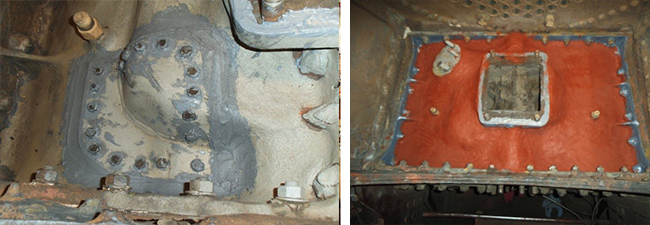As a part of the celebration of the London Underground’s 150th anniversary, the steam locomotive Metropolitan No. 1, built in 1898, was scheduled to make a number of trips on the city’s Metropolitan line. After a steam leak in the original cylinder block was detected, Belzona was contacted to see whether a high temperature resistant epoxy coating could solve the problem.

1. 116-year-old steam train 2. Badly corroded steam chest
Following
an inspection by a Belzona Engineer, it was detected that the steam chest,
which is part of the main cylinder block on the engine, had corroded and had
several holes due to steam pressure and exposure to corrosive chemicals over
many years. Without fixing these holes, the engine would lose pressure and fail
to run. Replacing the steam chest would have required a massive amount of work,
both in dismantling the engine and removing the cylinder block as well as
having another cylinder block made. This process would not only be highly time
and labor intensive but cost prohibitive as well. To bypass this time-consuming
and expensive process, the client chose to repair the damaged steam chest with
a combination of long-term, Belzona repair and protection systems.
To seal
the holes in the steam chest, Belzona 1511 (Super HT-Metal), a high temperature
repair system specifically designed for rebuilding metals damaged by corrosion,
was specified to bond steel plates over the damaged areas. Following this, Belzona
1391 (Ceramic HT) was then specified to coat the application area as this will
provide further erosion and corrosion resistance to the high temperature area.
Finally, to seal and level the repair, the extremely durable, heat resistant
epoxy repair composite, Belzona 4181 (AHR Magma-Quartz) was specified.
The first step in the
repair of Met 1’s steam chest was to bond steel plates over the holed areas of
the cast iron substrate. Prior to this, the area was cleaned and grit blasted
before the plates were bonded into place. Belzona 1511 was applied all around
the plate edges to bond and seal the plates as they were tightened into place
by the bolt heads. The edges of the plates were then profiled smoothly with the
same material to remove any sharp edges around the plates and to give a neat
finish.
Next, one coat of Belzona 1391, which is designed to operate under
continuous immersion up to 120°C (248°F), was applied. This system was used
over the entire top of the steam chest at a thickness of 813–1,016µm.

3. Plates bonded with epoxy repair composite 4. Acid and heat resistant
epoxy system
At this point, it was time to apply Belzona
4181, an acid and heat-resistant screed. The system was applied at around 50mm
thick to seal and level the area as well as to provide extra protection from
corrosive chemicals and steam vapour produced by the coal and combustion
process.
Belzona Restores a Piece of London’s Heritage
The
application of a modern, epoxy polymer system made it possible to continue
operating the locomotive which is more than 100 years old. This is particularly
significant considering the Met 1 is the only working steam train left in the
United Kingdom that was actually built in London. Therefore the use of a
Belzona repair and protection system played a vital role in preserving an
important piece of London’s heritage.
Written by Chloe Hirst
www.belzona.com